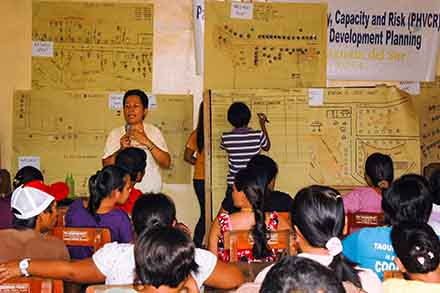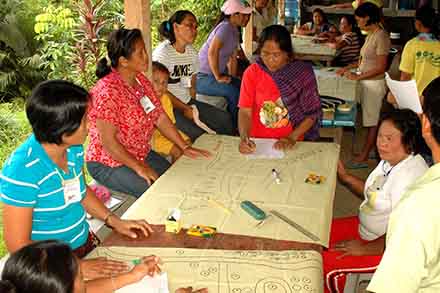Irenea Esencia, or Nanay Neneng to most in her town, has been a Barangay Health Worker (BHW) in the Angas village on the southern Philippine island of Mindanao since 1969. In her 45 years of community service as a BHW, Nanay witnessed how the community was transformed into what it is now. Many things in the community changed, including the culture, civilization, livelihood, government, politics, religion, values, and even the weather and climate pattern over time.
Nanay, who is now in her 80’s, is part the Resilience Initiatives through Sustainable Enterprises and Upgrade of Community Preparedness (RISE UP) Project co-funded by Heifer International and the Margaret Cargil Foundation (MAC) and implemented by the HEED Foundation, Inc. She recently served as a key informant and respondent in a Community-Managed Disaster Risk Reduction Workshop (CMDDR) in Angas May 19-21, 2014.

During the workshop, Nanay was seen flipping through the pages of her documents (calling them her archives) of Santa Josefa’s history. She traced the timeline of the widespread disease recorded in the history of the village. The illnesses caused by bacterial and viral infections were due to direct skin contact with contaminated flood water. According to Nanay, this happened often, especially in the low lying part of the village where families of rice-cultivating farmers lived. She also mentioned cholera outbreak, e-coli, amoeba, parasites, and other related disease that attack the human immune system, all of which are caused by floods and other weather related disturbances.
Nanay is seen as a fountain of information in her community. She makes intelligent observations and provides very thorough, evidenced-based information. During meetings, where she always actively participates, she shares her knowledge, experience and wisdom with other members.

Nanay shared how the changes in the community were caused by influences of urbanization. She described the lifestyle of the Angasnon (people in the village of Angas) before their time, explaining the indigenous farming systems they employed that were less laborious and required little to no expenses. “In this village before people lived harmoniously, sharing their abundance of natural resources,” Nanay explained. “Now, everything has changed. We buy drinking water because our water is no longer safe. The soil requires expensive fertilizers in order to grow plants because the nutrients are depleted. Farmer’s produce is not healthy for human consumption due to contamination.”
Nanay is a true inspiration to the community. Her participation in the workshop was a great contribution in designing a comprehensive Development Plan of the village, which will benefit the entire community of Santa Josefa.
After a while, Nanay added, “It’s not too late. There is still hope. Everyone at this workshop has a sincere intention to change everything for the better. I am still hopeful that we can resuscitate our environment. Big things begin with small, steady steps.”
Story and photos by Forcep dela Torre, Program Officer, Heifer Southern Philippines with inputs from Karla Narcise-Rodulfo, PME Manager Heifer Philippines
